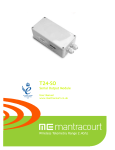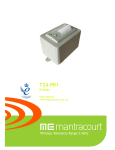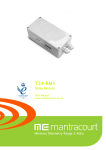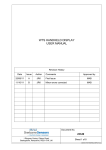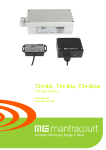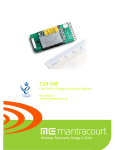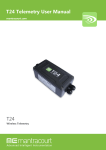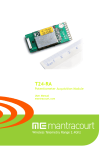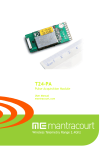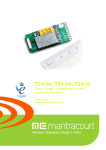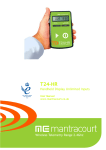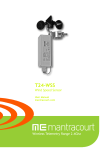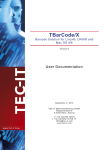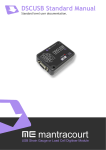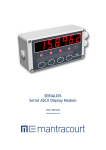Download Wireless telemetry printer and display driver T24-SO
Transcript
T24-SO
Serial Output Module
User Manual
mantracourt.com
Introduction / Overview ........................................................................................................2
Communications Overview ................................................................................................... 2
Configuration Overview ....................................................................................................... 2
Getting Started ................................................................................................................. 3
Connecting Power ........................................................................................................... 3
T24-SO ...................................................................................................................... 3
Serial Settings ................................................................................................................... 3
T24-SO Operation ............................................................................................................ 4
Configuration......................................................................................................................4
Installation ...................................................................................................................... 4
T24 Toolkit.................................................................................................................... 4
T24-BSu Base Station ....................................................................................................... 4
T24 Toolkit ...................................................................................................................... 5
General Pages ................................................................................................................ 5
Setup Base Station Communications .................................................................................. 5
Home ........................................................................................................................ 6
Analyser .................................................................................................................... 7
Information ................................................................................................................ 8
Channel and Encryption ................................................................................................. 9
Save and Restore........................................................................................................ 10
Input Settings ............................................................................................................ 11
Output Settings ......................................................................................................... 13
Output Scaling ........................................................................................................... 15
Output Design ........................................................................................................... 16
Zero Settings ............................................................................................................ 18
Zero Settings Advanced ................................................................................................ 19
Configuration Examples ...................................................................................................... 20
LED Display from a Single Source .......................................................................................... 20
Summed LED Display from Dual Source .................................................................................. 20
Print Gross Sum of 2 Devices to Printer .................................................................................. 20
Customer Ticket From Handheld Device ................................................................................. 21
Installation ....................................................................................................................... 22
Overview ....................................................................................................................... 22
Specifications ................................................................................................................... 23
General Radio ................................................................................................................. 23
T24-SO .......................................................................................................................... 23
Approvals ........................................................................................................................ 24
CE ............................................................................................................................... 24
FCC.............................................................................................................................. 24
Industry Canada .............................................................................................................. 25
OEM / Reseller Marking and Documentation Requirements .......................................................... 25
FCC.............................................................................................................................. 25
IC ................................................................................................................................ 25
CE ............................................................................................................................... 25
Declaration of Conformity ................................................................................................... 27
Worldwide Regional Approvals .............................................................................................. 28
Important Note ............................................................................................................ 28
Warranty ......................................................................................................................... 28
1
Mantracourt Electronics Limited T24-SO User Manual
Introduction / Overview
The T24-SO creates a serial output which can include data from up to 8 devices and optionally sum them. The
output is suitable for connecting to a printer, serial display or for feeding directly into a PC, PLC or any device
that is capable of using numeric values in readable ASCII format.
The actual serial output can be designed by the user using multiple lines which can include free text or tokens
which can represent real data. i.e. <V1> would be decoded as the value from input 1 when the print is
triggered.
Printing can be triggered from a contact, an external command or the arrival of a specific Data Provider
message.
The serial output can consist of a single line of data suitable for feeding into an LED display module or a more
complex multi-line result that can contain a mixture of fixed and variable data suitable for tickets, receipts etc
for printed output.
Communications Overview
The T24 range of telemetry devices each have a factory set unique ID.
Data is shared between devices using Data Provider messages. A device generates these messages which can
then be used by many other devices simultaneously.
These messages ( or packets ) of information contain a single value of data and each is identified by a Data
Tag.
The Data Tag should be unique for each message.
ID
Identifies each device
Each device has a unique ID that is factory set. This is represented as a 6 character hexadecimal
number consisting of the digits 0 to 9 and the letters A to F.
I.e. FFD3BE
Data Tag
Identifies each Data Provider message
A Data Tag consists of a 4 character hexadecimal number consisting of the digits 0 to 9 and the
letters A to F. The Data Tag can be changed by the user but the factory default is to match the
last 4 characters of the device ID.
I.e. An acquisition device of ID FFC12B would have a default Data Tag of C12B.
When a device consumes data (i.e. a handheld displaying data from an acquisition device) all it is doing is
listening to all of the Data Provider messages and selecting the one it wants to use. It then extracts the data
and displays it.
Some devices that use Data Provider messages also need to know the ID of the device providing the data. This
is necessary if that device needs to specifically wake the data providing device as opposed to using a broadcast
wake that will wake all devices on the same channel and using the same encryption key.
Pairing offers an automated method of hooking a provider and consumer of data together. However, some
devices may require you to manually enter Data Tag and ID information so it would be beneficial to the user to
understand the above mechanism.
Configuration Overview
Once it has been determined how many devices are feeding data to this device you need to record the Data Tag
that each of these devices are attaching to their Data Provider packets.
These Data Tags are then entered into the ValueDataTagx parameters. Once the rate at which this data arrives
is known you can enter the Timeoutx values.
Leave unused ValueDataTagx parameters with a value of zero to ensure that they are not checked for timeouts
and do not contribute to gross or net sums.
When a data provider packet arrives whose Data Tag matches one of those in the ValueDataTagx parameters
the value it contains will be placed in the Valuex parameter.
If data does not arrive from a device within the Timeoutx period then any reference to either the individual Vx
tokens or one of the summing tokens will result in ------ rather than a numeric value.
Mantracourt Electronics Limited T24-SO User Manual
2
The actual serial output can now be constructed using Line1 to Line25. These parameters take text into which
you can insert tokens. When a 'Print' is generated these lines are parsed and tokens replaced with the values
they represent and the resulting data sent to the serial port.
A 'Print' is generated by either activating the switch input when SwitchMode is set to zero or by receiving a
Data Provider packet whose Data Tag matches the PrintDataTag parameter.
When a 'Print' is executed each of the parameters Line1 to Line 25 will be parsed. Every token will be evaluated
and replaced with the live value.
Getting Started
To attach acquisition devices to the T24-SO we must first ensure that the appropriate devices are transmitting
their values at a suitable rate such as the default of 3 per second. Then we can configure the module to use
the data from these devices.
Configuration must be done with the T24 Toolkit software and a base station.
Connecting Power
T24-SO
You will need to connect power and serial to the T24-SO for it to operate. Only power is required to enable
configuration using a base station and the appropriate toolkit software.
2 TX
3 RX
5 GND
8 CTS
5
1
9
6
ON
GND
INPUT
J5
1
8
Switch
Serial Settings
The serial output is set at 8 data bits, 1 stop bit and no parity. The baudrate can be selected as can RS232 or
RS485 operation.
SW1 Settings
Switch positions 1 to 4 are not used.
Switch positions 5 to 7 control the baudrate for the serial interface. Whether the serial interface is RS485 or
RS232 is selected by switch position 8.
5
Baudrate
NA
Off
3
6
7
Off
Off
Mantracourt Electronics Limited T24-SO User Manual
9600
19200
38400
57600
115200
230400
460800
On
Off
On
Off
On
Off
On
Off
On
On
Off
Off
On
On
Off
Off
Off
On
On
On
On
This switch position selects whether the serial interface is RS232 or RS485.
232/485
RS232
RS485
8
Off
On
T24-SO Operation
The only way to affect operation of the T24-SO is as follows:
The digital input (switch input) which may trigger an output/print or tare the summed value.
Arrival of a data packet identified with a Data Tag that matches what the T24-SO uses to trigger an
output/print.
Arrival of a command to trigger an output/print or to tare or zero etc.
Configuration
This section explains how to install software and connect the required devices together. Please note that you
will need the T24 Toolkit software and a T24-BS base station to allow your computer to communicate with T24
telemetry devices.
Installation
T24 Toolkit
To configure the devices we must use the T24 Toolkit software application. This can be downloaded from our
web site or may be shipped with your products.
Install this on a PC or laptop.
Run setup.exe and follow the prompts to install the software.
T24-BSu Base Station
If you have a USB version of the base station (T24-BSu) then you just need to plug this into a USB socket on your
PC. If you are using an alternative base station then please refer to the appropriate manual.
Mantracourt Electronics Limited T24-SO User Manual
4
T24 Toolkit
The T24 Toolkit provides a means of simple configuration of the T24-SO and associated acquisition module
along with useful tools to aid integration. Calibration of the acquisition modules is also provided.
Run the T24 Toolkit software application.
General Pages
Setup Base Station Communications
Select USB as the interface and select 1 as the Base Station Address.
In the toolkit all items that can be changed by the user are coloured orange.
To change a value just click on the relevant orange item. You will then be presented with a new dialog window
allowing you to change the value.
This may use a slider, text box or list to allow your new value to be entered.
Click the Home button to attempt communications with the base station.
If no communications can be established the toolkit will remain on this page. You will need to check that the
base station is powered and that it is connected to the converter correctly.
5
Mantracourt Electronics Limited T24-SO User Manual
Home
We now have successful communications with the base station so we can now pair with our device or we can
select the Spectrum Analyser mode or Data Provider Monitor mode.
Pairing
•
•
•
Procedure
Remove power from the T24-SO module.
Click the Pair button on the toolkit.
You now have 10 seconds to re-apply power to the T24-SO module.
If you connect successfully the toolkit will change to the Information page.
If the pairing fails try again.
NOTE: The act of Pairing with the toolkit will not change the radio configuration settings of the connected
device. The settings will only change if you change them yourself within the toolkit.
Mantracourt Electronics Limited T24-SO User Manual
6
Analyser
The analyser page is provided as a tool and will not normally be needed unless you plan to change channels and
want to find the best channel to select, or to diagnose poor communications issues.
This page shows the radio signal levels detected across all the channels available to the T24 series of devices.
Using this tool may help in detecting noisy areas and allow you to decide on which channels you may want to
use.
The above charts show the traffic from a Wi-Fi network and it can be seen to be operating over channels 6 to 9
and it would be best (though not essential) to avoid using these channels.
7
Mantracourt Electronics Limited T24-SO User Manual
Information
This page shows you information about the connected device.
Items you can change:
Name
You can enter a short descriptive name (11 characters) which may help you recognise this
device in the future.
Mantracourt Electronics Limited T24-SO User Manual
8
Channel and Encryption
Here you can change the channel and encryption key for the module.
NOTE: Early acquisition module do not yet utilise the encryption keys so these should be left at all zeros.
Items you can change:
Channel
Encryption Key
9
Select a channel between 1 and 16. The default is channel 1. You can use the
Spectrum Analyser mode to determine a good clean channel to use.
NOTE: Channel 16 is used to negotiate pairing so avoid this channel if possible.
Only devices with identical encryption keys can communicate. You can isolate
groups of devices on the same channel or just use the key to ensure the data
cannot be read by somebody else.
Mantracourt Electronics Limited T24-SO User Manual
Save and Restore
Here you can save the device settings to a file on your PC so that they can be later loaded back into the same
or different device.
Items you can change:
Save
Click this button to open a file dialog window to allow you to select a filename
and location to save the configuration file to.
All configuration information including calibration data will be saved to the
file.
The file extension is tcf.
Restore
Click this button to open a file dialog window to allow you to select a filename
and location of a previously saved file to load into the connected device.
All configuration information including calibration data will be overwritten.
The file extension is tcf.
Advanced Settings
Click this button to enter the Advanced Settings Page.
Here are settings which do not normally require changing.
Mantracourt Electronics Limited T24-SO User Manual
10
Input Settings
Here you can set the action to take when the switch contacts are closed, set the Data Tag that will trigger an
output and also set the Data Tags of the data used as the inputs along with how the data is formatted.
Items you can change:
Waker Duration
Enter the number of seconds the display module will attempt to wake
acquisition modules when it is first powered up. Enter zero to disable this
feature. NOTE: all acquisition modules on the same radio channel as the
display module will be woken. Use the SleepDelay settings in the acquisition
modules to let them return to sleep after the display module is switched off.
This is only available for firmware versions 1.08 and above.
Output Trigger Data Tag
Enter the Data Tag which, on arrival, will trigger an output (I.e print). Note
that Min Interval setting on the Output Settings page may stop this from
working at the rate at which the data arrives.
This is usually set to the Data Tag of one of the inputs.
Example: If the output was being sent to a serial display the same Data Tag
would be assigned to input 1 and the output trigger so that each time data
arrived the output would be sent to the serial display.
Switch Mode
Click to select either:
Print – Triggers an output from the serial port. Note that Min Interval setting
on the Output Settings page may stop this from working at the rate the
contact closes.
Gross/Zero – Toggles the measurement mode between gross and net. When
switching to net the net value is zeroed (tared). This will affect the value of
the <N> token which is the net value of all summed inputs.
Remote data Tags and Timeouts
Data Tag
Enter the Data Tag (in hexadecimal) to supply data to this input.
11
Mantracourt Electronics Limited T24-SO User Manual
Timeout
Format
NOTE: You can click the P button to retrieve the Data Tag of a device by
pairing to it which is usually initiated by power cycling the module.
Clicking the X button zeroes the entered Data Tag.
Enter the timeout in milliseconds for this input. If a new Data Provider packet
does not arrive within this time and reference to this input value (via token
<V1> for example) will result in an output of -------. This also applies to a gross
or net reading derived from this input.
Describe the format that this value is to take when output. You specify integer
digits and decimal places by entering a format consisting of zeroes and
decimal points. i.e. 00.000
NOTE: The integer value of data takes precedent over your defined format so
if you defined a format of 0.0 and data of value 100.8765 arrived it would be
represented as 100.8
Examples
Format
0.0
0.0
00.000
00.000
0000.00
Value
1.2
100.8
6.1234
123.4567
12.0
Representation
1.2
100.8
06.123
123.456
0012.00
Resolution
It is possible to set the resolution (the smallest unit of change) of the output
results by including the numeric value in the format. i.e.
00.005 would only represent the value in steps of 00.005
Mantracourt Electronics Limited T24-SO User Manual
12
Output Settings
Here you can change various settings that influence the output from the module.
Items you can change:
Duplicate
Whether to produce the same output twice each time an output is triggered.
Useful, for example, with a printed output where a customer requires a
receipt.
Min Interval
Minimum time allowed between triggered outputs entered in milliseconds.
Triggers arriving within this time since the previous trigger will be ignored.
Example: A Data Tag is used to supply data to input 1 and is used to trigger an
output. This data arrives at a rate of 50 per second but the output is
connected to a serial display which would have problems if it were sent data
at this rate. By setting the Min Interval to 300 the outputs would be limited to
3 per second even though the data was arriving at a higher rate.
Gross Text
Enter text to replace the <GN> token with when the device is in gross mode.
Net Text
Enter text to replace the <GN> token with when the device is in net mode.
Print On Error
Whether to trigger an output when any input device fails to deliver new data
within the timeout period.
Example: Data arrives which is used as input 1. This same data tag is used to
trigger an output which is sent to a serial display. Normally if the data fails to
arrive the display would not get updated as no output would occur. By setting
this property an output would be triggered when the data failed to arrive thus
setting the serial display which would show ------- instead of the value when
<V1> is decoded.
Log Number
Enter a log number that is used when the <LOG> token is decoded. Each time
13
Mantracourt Electronics Limited T24-SO User Manual
an output is triggered this log number is incremented. This number will wrap
to zero once it reaches the maximum value displayable due to the Log Digits.
Log Number (Non Volatile)
The Log number defaults to being volatile. Power cycling the T24-SO will
revert the log number to the value seen on this page. This is ideal for when
you have a fast output and you want the outputs to be numbered sequentially.
i.e. with a fast output being sent to a data logger.
Sometime it is required that the log number is Non Volatile, that is, the log
number is restored each time the T24-SO is power cycled.
This is useful when the output is used to drive a printer, for example, and the
log number acts as a unique number on the customer ticket.
When set to Yes the module must store the new Log Number each time it is
incremented. This takes time and also uses up the finite write cycles of the
internal flash memory. Therefore it is recommended that turning on the Non
Volatile option is only done when the output (containing a <LOG> token) is
triggered at 30 second intervals or less.
Log Digits
Set the number of digits to display when the <LOG> token is decoded.
Example: If this is set to 2 then the log number will count up to 99 before
resetting.
Line Delay Char
As the serial output is has no hardware handshaking it is sometimes necessary
to limit the rate at which the output is sent. This is most apparent with
multiline outputs to a printer.
Example: A printer requires a 0x0A (decimal 10) character (linefeed) to be
sent at the end of each line to cause the printer to actually print the line.
This character would be embedded in the actual designed output and the Line
Delay Char set to 0A so each time a line is sent to the printer a delay occurs
before the next part of the output is initiated. The delay is set by Line Delay.
Line Delay
The delay in milliseconds that occurs when the Line Delay Character has been
sent to the output.
Mantracourt Electronics Limited T24-SO User Manual
14
Output Scaling
This page allows effective conversion between units. i.e. Although all devices supplying data are configured in
Kg you can get a printed output in Lbs.
Items you can change:
Custom Display Scaling
This can be used to change the displayed value to a different unit or to
otherwise scale it. You simply enter the original and required values at a low
and high point.
Example: If a T24-SA was supplying data in Kgs and you wanted to show tonnes.
You would keep both the low points at zero. Enter At High Input Value of 1000
and Display Should Read Value of 1.
NOTE: This affects all inputs and sums (both gross and net). All tokens will
effectively be decoded using the new scale factor.
15
Mantracourt Electronics Limited T24-SO User Manual
Output Design
This is where you define the actual output based on free text and tokens.
Tokens are special codes contained within angled brackets <token> which have special meanings and are
converted to actual values once an output is triggered.
See list of tokens at the bottom of this section.
Items you can change:
End Of Line Token
Design Area
When you press the Enter key on the keyboard we need to know which token
to include in the design area. For single line outputs this is not an issue but for
multiline printer outputs for example it becomes important. You need to know
what character is used to cause the printer buffer to be printed. For this you
will need to refer to the printer manual. Some printers just require a Carriage
Return <0D> and some may require a Line Feed <0A> or some may require both
<NL>. You would need to set the Line Delay Char on the Output Settings page
to the appropriate character. And here you can select whether to use that
character each time Enter is pressed or you can opt for <NL>.
This is where you create your output using a mixture of free text and tokens.
See the example in the screenshot above.
To enter a token you can type it in or double click the token list on the right
of the page (a single click will display the description of the token).
Available Tokens
Token
Function
<V1> …
Substitutes token with the last value received from the input. This
<V8>
will already have system zero subtracted (If a DoSysZero command
has been issued.) and tare subtracted. (If a DoTare command has
been issued or the switch input has executed a tare.)
Mantracourt Electronics Limited T24-SO User Manual
Example
1.2345
16
<GV1> …
<GV8>
<RV1> …
<RV8>
<TV>
<LOG>
<G>
<N>
<EZ>
<GN>
<xx>
Substitutes token with the last value received from the input. This
will already have system zero subtracted (If a DoSysZero command
has been issued.) but no tare subtracted. i.e. it will always
contain the Gross value of the specified input.
Substitutes token with the last value received from the input. This
will NOT have system zero or tare values subtracted.
Substitutes token with the value carried in the Data Provider
packet that has triggered the 'Print'.
Substitutes token with the log value. Each time a 'Print' occurs the
log number will be incremented.
Substitutes token with the Gross sum of all active inputs. System
zero values will have been extracted.
Substitutes token with the Net sum of all active inputs. System
zeros will have been subtracted and also if a Tare has been issued
then the tare value will be extracted.
Substitutes token with the External System Zero.
Substitutes token with the GrossText or NetText parameter
contents depending on the NetMode.
Substitutes token with the ASCII character whose ASCII value is xx
where xx is a two digit hexadecimal value. i.e. <0D>
Below are listed some useful hex codes.
Hex Value
Token
<0D>
<0A>
<09>
<1B>
17
Description
Carriage Return
Line Feed
Tab
Escape
Mantracourt Electronics Limited T24-SO User Manual
1.2345
1.2345
1.2345
0003
1.2345
1.2345
1.2345
Gross
ÆӪ-ü▀
Zero Settings
Here you can set a system zero.
Items you can change:
Perform System Zero
Remove System Zero
Clicking this will store the current values on all inputs and subtract the value
from all subsequent outputs thus rendering the current input as zero.
Example: A 4 input weigh platform will have calibrated acquisition modules
but when the actual platform structure is in place each module has a weight
value thus the gross value is 50Kg.
By performing a system zero (with all inputs operational) this is zeroed away
so next time the T24-SO is powered on the same input will yield a zero result.
Clicking this will remove all system zeros and restore all outputs normal.
Mantracourt Electronics Limited T24-SO User Manual
18
Zero Settings Advanced
This advanced section allows the use of a specially configured external module to supply the system zero value
for the handheld to use.
Example:
The same T24-SO is used with a truck that picks up different trailers and is required to display the sum of 4
strain gauges connected to each trailer (Using T24-SAs).
Because each trailer will have a different system zero requirement we would add a further device to each
trailer set to transmit the system zero value. It is the Data Tag that is entered here.
Note: On all trailers the acquisition module sets share the same Data Tags.
Items you can change:
Data Tag Enter the Data Tag of the message to use for the external system zero.
ID
Contains the ID of the device used to supply the external system zero. This is only necessary to
provide a visible record of the remote device and is shown to keep compatibility with the Mode
and Communications page.
You do not need to enter anything here although it will be filled in automatically if you perform a
pair to retrieve data.
P
Click this to give 5 seconds to perform pairing to automatically provide the Data Tag and ID from a
specific device. Usually pairing is activated by removing and replacing the power supply.
X
Click this to reset the Data Tag and ID to zero (disabling the external system zero function).
19
Mantracourt Electronics Limited T24-SO User Manual
Configuration Examples
LED Display from a Single Source
We want to put data from a T24-SA onto a large LED display.
We will use the out of the box rate of 3 per second. The display only needs the ASCII data followed by a
carriage return.
Assuming the T24-SA sends its data on Data Tag C675
Line1=<V1><0D>
V1Format=00.000
Timeout1=2000
ValueDataTag1=C675
PrintDataTag=C675
MinInterval=100
LineDelay=0
PrintOnError=1
SwitchMode=1
Summed LED Display from Dual Source
We want to put the summed Net data from a pair of T24-SAs onto a large LED display. We want the switch
input of the T24-SO to toggle between Gross and zeroed net mode. (The printed output will reflect whether the
device is in gross or zeroed net mode).
We will use the out of the box rate of 3 per second. The display only needs the ASCII data followed by a
carriage return.
Assuming the T24-SAs send data on Data Tag C675 and FF34
Parameter settings:
Line1=<NET><0D>
FormatSUM=00.000
ValueDataTag1=C675
ValueDataTag2=FF34
PrintTrigger=C675
MinInterval=100
LineDelay=0
PrintOnError=1
SwitchMode=1
Print Gross Sum of 2 Devices to Printer
We need to print the gross sum of 2 devices to a printer with each time the switch input is activated on the
T24-SO.
We need to display the value of each input as well as the gross sum.
The printer is not very fast so we can only send a line every 50mS. Also we do not want to print more often
than once every 30 seconds even if the switch is pressed. The printer requires a linefeed 0x0A at the end of
each line.
We want the printed output to look like:
Mantracourt Electronics Ltd
Weigh Station #1
Input 1: xx.xxxx Kg
Input 2: xx.xxxx Kg
-------------------Sum: xx.xxxx Kg
For assistance call
Mantracourt Electronics Limited T24-SO User Manual
20
0871 345672
Parameter settings:
Line1=Mantracourt Electronics Ltd<0D><0A>
Line2=Weigh Station #1<0D><0A>
Line3=<0D><0A>
Line4=Input 1:<V1> Kg<0D><0A>
Line5=Input 2:<V2> Kg<0D><0A>
Line6=---------------------<0D><0A>
Line7=Sum:
<GRO>Kg<0D><0A>
Line8=<0D><0A>
Line9=For assistance call<0D><0A>
Line10=0871 345672<0D><0A>
V1Format=00.0000
V2Format=00.0000
SumFormat=00.0000
ValueDataTag1=C675
ValueDataTag2=FF34
PrintTrigger=0000
LineDelayChar=0A
LineDelay=50
MinInterval=10000
SwitchMode=0
Customer Ticket From Handheld Device
We have a handheld device T24-HA already configured to sum data from 4 devices. We want the F1 button on
the handheld to trigger a printout to a serial printer connected to the T24-SO.
We only want to print the gross sum that the handheld passes us. The handheld is configured to send the Gross
value as Data Tag ABCD when the F1 button is pressed. This is referenced using the <TV> token (Trigger Value).
The printer is not very fast so we can only send a line every 50mS. Also we do not want to print more often
than once every 5 seconds even if the handheld tries to do so. The printer requires a carriage return 0x0D and
linefeed 0x0A at the end of each line.
We also want two tickets printed each time it is triggered.
We want the printed output to look like:
Mantracourt Electronics Ltd
Weighment: xx.xxxx Kg
Parameter settings:
Line1=Mantracourt Electronics Ltd<NL>
Line2=Weighment: <TV> Kg<NL>
SumFormat=00.0000
PrintTrigger=ABCD
LineDelayChar=OD
LineDelay=50
MinInterval=5000
Duplicate=1
21
Mantracourt Electronics Limited T24-SO User Manual
Installation
Overview
Radio performance at microwave wavelengths is very dependent upon the operating environment; any
structure within the operating region of the radios will give rise to three effects:
Obscuration. Obscuration will result in reduced range and occurs when an obstruction masks the line-of-sight
between radios.
Aberrations to the horizontal and vertical space patterns. Distortion of these patterns may occur if
structures or objects are placed in the near or intermediate field of the antenna. The effect will be to distort
the coverage patterns, adversely affecting range and link quality.
Reflection. Any object placed in line-of-sight of the transmit antenna will result in signals arriving at the
receiver by an indirect path. Degradation of performance due to reflection (multipath effects) appears as
reduced range or poor link quality.
Any of the above will cause poor RSSI figures, an increase in the packet loss rate and in extreme cases
complete loss of signal. Fortunately, if consideration is given to these effects at the integration stage then a
good quality link will be obtained.
Guidelines for product design:
When selecting materials for product enclosures, preference should be given to fibreglass, light coloured ABS or
Polypropylene; at the wavelength of 2.4GHz radio other materials will adversely affect the signal by
attenuation, refraction or change in polarisation.
If the application demands that the radio is fitted inside a metal enclosure then ensure that the specified
clearances are maintained around the antenna and design in a fibreglass RF window at least as large as the
clearance dimensions but ideally as large as possible.
RAD24i radios fitted inside a product should be oriented so that the chip antenna will be vertical when the
product is in its normal operating position.
Guidelines for installation:
When planning installations ensure that line-of –sight between nodes is maintained and that objects or
structures are kept at least one metre away from antennae wherever possible.
To avoid poor link quality between a RAD24i radio and a handheld device ensure that the RAD24i is mounted so
that the chip antenna is vertical. Improvement may also be obtained by altering the height above ground of the
RAD24i; a small increase or reduction in antenna elevation will often improve reception.
Range underwater is only a decimetre or so depending on packet rate. Best performance underwater is
obtained by using low packet rates and immersing water-proofed antennae rather than water-tight enclosures
containing the antennae.
Mantracourt Electronics Limited T24-SO User Manual
22
Specifications
General Radio
Min
License
Modulation method
Radio type
Data rate
Radio Frequency
Power
Range
Channels (DSSS)
Typical
License Exempt
MS (QPSK)
Transceiver (2 way)
250
2.4000
Max
2.4835
1
200 (650)
Units
K bits/sec
GHz
mw
Metres (feet) *
16
* Maximum range achieved in open field site at a height of 3 metres above ground.
T24-SO
Parameter
External Supply voltage Range
USB Supply Range
Min
4.5
4.875
Typical
12
5
Max
32
5.125
Units
V DC
V DC
Average Operational Current
USB Bus Powered Operational
Current
Operating Temperature Range
Storage Temperature Range
Reverse polarity Protection
100
TBD
500
200
mA
-40
-40
-
85
85
-32
Deg C
Deg C
V DC
IP65
95
%RH
Humidity
IP Rating
0
Note: USB connector is for power supply only.
23
Mantracourt Electronics Limited T24-SO User Manual
Notes
As defined by USB
2.0 Specification
Maximum Supply
level
Approvals
CE
Complies with EMC directive. 2004/108/EC
The Radio Equipment and Telecommunications Terminal Equipment (R&TTE) Directive,
1999/5/EC,
European Community, Switzerland, Norway, Iceland, and Liechtenstein
English:
This equipment is in compliance with the essential requirements and other relevant provisions of
Directive 1999/5/EC.
Deutsch:
Dieses Gerät entspricht den grundlegenden Anforderungen und den weiteren entsprecheneden
Vorgaben der Richtlinie 1999/5/EU.
Dansk:
Dette udstyr er i overensstemmelse med de væsentlige krav og andre relevante bestemmelser i
Directiv 1999/5/EF.
Español:
Este equipo cumple con los requisitos esenciales asi como con otras disposiciones de la Directive
1999/5/EC.
Français:
Cet appareil est conforme aux exigencies essentialles et aux autres dispositions pertinantes de la
Directive 1999/5/EC.
Íslenska:
Þessi búnaður samrýmist lögboðnum kröfum og öðrum ákvæðum tilskipunar 1999/5/ESB.
Italiano:
Questo apparato é conforme ai requisiti essenziali ed agli altri principi sanciti dalla Direttiva
1999/5/EC.
Nederlands: Deze apparatuur voldoet aan de belangrijkste eisen en andere voorzieningen van richtlijn
1999/5/EC.
Norsk:
Dette utstyret er i samsvar med de grunnleggende krav og andre relevante bestemmelser i EUdirectiv 1999/5/EC.
Português:
Este equipamento satisfaz os requisitos essenciais e outras provisões da Directiva 1999/5/EC.
Suomalainen: Tämä laite täyttää direktiivin 1999/5/EY oleelliset vaatimukset ja on siinä asetettujen muidenkin
ehtojen mukainen.
Svenska:
Denna utrustning är i överensstämmelse med de väsentliga kraven och andra relevanta
bestämmelser i Direktiv 1999/5/EC.
This equipment is in compliance with the essential requirements and other relevant provisions of Directive
1999/5/EC.
FCC
Family: RAD24
Models: i and e for internal and external antenna variants. For antenna T24-ANTA and T24-ANTB
FCC ID:VHARAD24
This device complies with Part 15c of the FCC Rules. Operation is subject to the following two conditions: (1) this
device may not cause harmful interference, and (2) this device must accept any interference received, including
interference that may cause undesired operation.
CAUTION: If the device is changed or modified without permission from Mantracourt Electronics Ltd, the user
may void his or her authority to operate the equipment.
Mantracourt Electronics Limited T24-SO User Manual
24
Industry Canada
Models: i and e for internal and external antenna variants. For antenna T24-ANTA and T24-ANTB
IC:7224A-RAD24
This apparatus complies with RSS-210 - Low-power Licence-exempt Radiocommunication Devices (All Frequency
Bands): Category I Equipment RSS.
OEM / Reseller Marking and Documentation Requirements
FCC
The Original Equipment Manufacturer (OEM) must ensure that FCC labelling requirements are met. This
includes a clearly visible label on the outside of the final product enclosure that displays the contents as
shown:
Contains FCC ID:VHARAD24
This device complies with Part 15 of the FCC Rules. Operation is subject to the following two conditions:
(1) this device may not cause harmful interference and
(2) this device must accept any interference received, including interference that may cause undesired operation.
The acquisition modules have been tested with T24-ANTA and T24-ANTB. When integrated in OEM products,
fixed antennas require installation preventing end-users from replacing them with non-approved antennas.
Antennas other than T24-ANTA and T24-ANTB must be tested to comply with FCC Section 15.203 (unique
antenna connectors) and Section 15.247 (emissions).
Acquisition modules have been certified by the FCC for use with other products without any further
certification (as per FCC section 2.1091). Changes or modifications not expressly approved by Mantracourt
could void the user’s authority to operate the equipment.
In order to fulfil the certification requirements, the OEM must comply with FCC regulations:
1. The system integrator must ensure that the text on the external label provided with this device is placed on
the outside of the final product.
2. The acquisition modules with external antennas may be used only with Approved Antennas that have been
tested by mantracourt.
IC
Labelling requirements for Industry Canada are similar to those of the FCC. A clearly visible label on the
outside of the final product enclosure must display the following text:
Contains Model RAD24 Radio (2.4 GHz), IC:7224A-RAD24
Integrator is responsible for its product to comply with RSS-210 - Low-power Licence-exempt
Radiocommunication Devices (All Frequency Bands): Category I Equipment RSS.
CE
The T24 series has been certified for several European countries.
If the acquisition module is incorporated into a product, the manufacturer must ensure compliance of the final
product to the European harmonized EMC and low-voltage/safety standards. A Declaration of Conformity must
be issued for each of these standards and kept on file as described in Annex II of the R&TTE Directive.
Furthermore, the manufacturer must maintain a copy of the T24 device user manual documentation and ensure
the final product does not exceed the specified power ratings, antenna specifications, and/or installation
requirements as specified in the user manual. If any of these specifications are exceeded in the final product, a
submission must be made to a notified body for compliance testing to all required standards.
OEM Labelling Requirements
The ‘CE’ marking must be affixed to a visible location on the OEM product.
25
Mantracourt Electronics Limited T24-SO User Manual
The CE mark shall consist of the initials “CE” taking the following form:
If the CE marking is reduced or enlarged, the proportions given in the above graduated drawing must be
respected.
The CE marking must have a height of at least 5mm except where this is not possible on account of the
nature of the apparatus.
The CE marking must be affixed visibly, legibly, and indelibly.
Mantracourt Electronics Limited T24-SO User Manual
26
Declaration of Conformity
We, Mantracourt Electronics Limited
The Drive
Farringdon
Exeter
Devon EX5 2JB
declare under our sole responsibility that our products in the T24 Radio Telemetry Product Range to which
this declaration relates are in conformity with the appropriate standard EN 300 328 following the provisions of
the Radio and Telecommunications Terminal Equipment Directive 1999/5/EC, FCC CFR Title 47 part 15c BS EN
61000-4-2 and BS EN 61000-4-3 following the provisions of the EMC Directive 2004/108/EC and Low Voltage
Directive 2006/95/EC.
December 2007
Brett James
Development Manager
Mantracourt Electronics Limited.
27
Mantracourt Electronics Limited T24-SO User Manual
FCC ID:VHARAD24
Worldwide Regional Approvals
Region
Europe
USA
Canada
Australia
China
Japan
Product Conforms To
CE
FCC
IC
To Be Determined
To Be Determined
To Be Determined
Important Note
Mantracourt does not list the entire set of standards that must be met for each country. Mantracourt customers
assume full responsibility for learning and meeting the required guidelines for each country in their distribution
market. For more information relating to European compliance of an OEM product incorporating the T24 range
of modules, contact Mantracourt, or refer to the following web site: www.ero.dk
Warranty
All Telemetry products from Mantracourt Electronics Ltd., ('Mantracourt') are warranted against defective
material and workmanship for a period of (1) one year from the date of dispatch.
If the 'Mantracourt' product you purchase appears to have a defect in material or workmanship or fails during
normal use within the period, please contact your Distributor, who will assist you in resolving the problem. If it
is necessary to return the product to 'Mantracourt' please include a note stating name, company, address,
phone number and a detailed description of the problem. Also, please indicate if it is a warranty repair.
The sender is responsible for shipping charges, freight insurance and proper packaging to prevent breakage in
transit.
'Mantracourt' warranty does not apply to defects resulting from action of the buyer such as mishandling,
improper interfacing, operation outside of design limits, improper repair or unauthorised modification.
No other warranties are expressed or implied. 'Mantracourt' specifically disclaims any implied warranties of
merchantability or fitness for a specific purpose. The remedies outlined above are the buyer’s only remedies.
'Mantracourt' will not be liable for direct, indirect, special, incidental or consequential damages whether based
on the contract, tort or other legal theory.
Any corrective maintenance required after the warranty period should be performed by 'Mantracourt' approved
personnel only.
In the interests of continued product development, Mantracourt Electronics Limited reserves the right to alter product specifications without prior notice.
Code No. 517-910
Mantracourt Electronics Limited T24-SO User Manual
Issue 1.7
24.03.14
28
Distribuidor
Brasil e América do Sul
C O N TA T O
Ender eço
Rua Sete de Setembro, 2671 - C entro
13560-181 - São C arlos - SP - Brasil
Telefone
+ 55 (16) 3371-0112
Metrolog Controles de Medição
Fax
+ 55 (16) 3372-7800
Inter net
www.metrolog.net
metrolog @metrolog.net
www.metrolog.net / mantracourt.com
[email protected]
tel +55 (16) 3371-0112






























